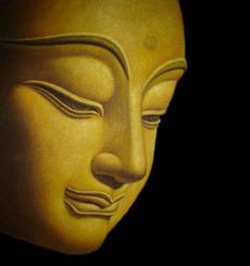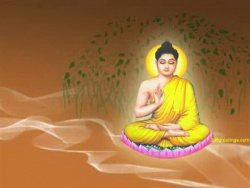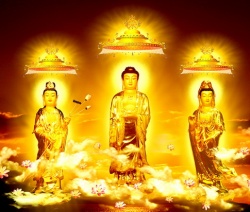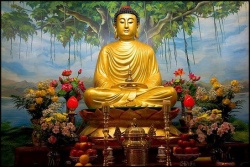Three marks of existence
The Three marks of existence, within Buddhism, are three characteristics (Pali: tilakkhaṇa; Sanskrit: trilakaṇa) shared by all sentient beings, namely: impermanence (anicca); suffering or unsatisfactoriness (dukkha); non-self (anattā).
According to Buddhist tradition, a full understanding of these three can bring an end to suffering (dukkha nirodha, 苦滅).
The Buddha taught that all beings conditioned by causes (saṅkhāra) are impermanent (anicca) and suffering (dukkhā) while he said not-self (anattā) characterizes all dhammas meaning there is no "I" or "mine" in the conditioned as well as the unconditioned (i.e. Nibbāna).[1]
The central figure of Buddhism, Siddhartha is believed to have achieved Nirvana and awakening after much meditation, thus becoming the Buddha Shakyamuni.
With the faculty of wisdom the Buddha directly perceived that all sentient beings (everything in the phenomenology of psychology) is marked by these three characteristics:
- Anicca (Sanskrit anitya) "inconstancy" or "impermanence".
This refers to the fact that all conditioned things (sankhara) are in a constant state of flux.
In reality there is no thing that ultimately ceases to exist; only the appearance of a thing ceases as it changes from one form to another. Imagine a leaf that falls to the ground and decomposes.
While the appearance and relative existence of the leaf ceases, the components that formed the leaf become particulate material that may go on to form new plants.
Buddhism teaches a middle way, avoiding the extreme views of eternalism and nihilism.
- Dukkha (Sanskrit duhkha) or dissatisfaction (or "dis-ease"; also often translated "suffering", though this is somewhat misleading).
Nothing found in the physical world or even the psychological realm can bring lasting deep satisfaction.
- Anatta (Sanskrit anatman) or "non-Self" is used in the suttas both as a noun and as a predicative adjective to denote that phenomena are not, or are without, a self; to describe any and all composite,
consubstantial, phenomenal and temporal things, from the macrocosmic to microcosmic, be it matter pertaining to the physical body or the cosmos at large, as well as any and all mental machinations, which are impermanent.
There is often a fourth Dharma Seal mentioned:
Together the three characteristics of existence are called ti-lakkhana in Pali or tri-laksana in Sanskrit.
By bringing the three (or four) seals into moment-to-moment experience through concentrated awareness, we are said to achieve wisdom—the third of the three higher trainings—the way out of samsara.
Thus the method for leaving samsara involves a deep-rooted change in world view.
Anicca
- See also :
- See also :
Pronounced Anitcha/Anitya All compounded phenomena (things and experiences) are inconstant, unsteady, and impermanent.
Everything we can experience through our senses is made up of parts, and its existence is dependent on external conditions.
Everything is in constant flux, and so conditions and the thing itself is constantly changing.
Things are constantly coming into being, and ceasing to be. Nothing lasts.
The important point here is that phenomena arise and cease according to (complex) conditions.
In Mahayana Buddhism, a caveat is added: one should indeed always meditate on the impermanence and transitory nature of compound structures and phenomena, but one must guard against extending this to the realm of Nirvana, where impermanence holds no sway.
In this view, the ultimate nature of reality is free from the stains of dualistic thought, and should therefore not be labeled as 'one' or the 'other' (i.e. 'permanent' or 'impermanent').
Dzongsar Jamyang Khyentse Rinpoche states that in the four seals of the Mahayana, Nirvana should be viewed as "beyond extremes".
Furthermore, he says "In many philosophies or religions, the final goal is something that you can hold on to and keep.
The final goal is the only thing that truly exists. But nirvana is not fabricated, so it is not something to be held on to.
It is referred to as 'beyond extremes.'
We somehow think that we can go somewhere where we’ll have a better sofa seat, a better shower system, a better sewer system, a nirvana where you don’t even have to have a remote control, where everything is there the moment you think of it.
But as I said earlier, it’s not that we are adding something new that was not there before.
Nirvana is achieved when you remove everything that was artificial and obscuring."
Dukkha
- Whatever is impermanent is subject to change. Whatever is subject to change is subject to suffering.
Anatta
- See also :
- See also :
In Indian philosophy, the concept of a self is called ātman (that is, "soul" or metaphysical self), which refers to an unchanging, permanent essence conceived by virtue of existence.
This concept and the related concept of Brahman, the Vedantic monistic ideal, which was regarded as an ultimate ātman for all beings, were indispensable for mainstream Indian metaphysics, logic, and science;
for all apparent things there had to be an underlying and persistent reality, akin to a Platonic form.
The Buddha rejected all concepts of ātman, emphasizing changeability not permanence.
He taught that all concepts of a substantial personal self were incorrect, and formed in the realm of ignorance.
The Buddha criticized conceiving theories even of a unitary soul or identity immanent in all things as unskillful in the Great Discourse on Causation.[2]
In fact, according to the Buddha's statement in Khandha Samyutta 47, all thoughts about self are necessarily, whether the thinker is aware of it or not, thoughts about the five aggregates or one of them.[3]
In a number of major Mahayana sutras (e.g. the Mahaparinirvana Sutra, the Tathagatagarbha Sutra,
the Srimala Sutra, among others), the Buddha is presented as clarifying this teaching by saying that, while the skandhas (constituents of the ordinary body and mind) are not the self, there does truly exist an eternal,
unchanging, blissful Buddha-essence in all sentient beings, which is the uncreated and deathless Buddha-nature ("Buddha-dhatu") or "True Self" of the Buddha himself.
The "tathagatagarbha"/Buddha nature does not represent a substantial self; rather, it is a positive language expression of "sunyata" (emptiness) and represents the potentiality to realize Buddhahood through Buddhist practices; the intention of the teaching of tathagatagarbha
(Buddha nature) is soteriological rather than theoretical.[4]
This immaculate Buddhic Self (atman) is in no way to be construed as a mundane, impermanent, suffering "ego", of which it is the diametrical opposite.
On the other hand, this Buddha-essence or Buddha-nature is also often explained as the potential for achieving Buddhahood, rather than an existing phenomenon one can grasp onto as being me or self.
Anatta is discussed in the Questions of King Milinda, composed during the period of the Hellenistic Indo-Greek kingdom of the 2nd and 1st centuries BCE.
In this text, the monk Nagasena demonstrates the concept of absolute "non-Self" by likening human beings to a chariot and challenges the Greek king "Milinda" (Menander) to find the essence of the chariot.
Nagasena states that just as a chariot is made up of a number of things, none of which are the essence of the chariot in isolation, without the other pieces, similarly no one part of a person is a permanent entity;
we can be broken up into five constituents – body, sensations, ideation, mental formations and consciousness – the consciousness being closest to the permanent idea of "Self", but is ever-changing with each new thought according to this viewpoint.
According to some thinkers both in the East and the West, the doctrine of "non-Self", may imply that Buddhism is a form of nihilism or something similar.
However, as thinkers like Nagarjuna have clearly pointed out, Buddhism is not simply a rejection of the concept of existence or meaning,
but of the hard and fast distinction between existence and non-existence, or rather between being and no-thingness.
Phenomena are not independent from causes and conditions and do not exist as isolated things as we perceive them to be.
The lack of a permanent, unchanging, substantial Self in beings and things does not mean that they do not experience growth and decay on the relative level.
But on the ultimate level of analysis, one cannot distinguish an object from its causes and conditions or even distinguish between object and subject (an idea appearing relatively recently in Western science).
Buddhism thus has much more in common with Western empiricism, pragmatism, anti-foundationalism, and even poststructuralism than with nihilism.
In the Nikāyas, the Buddha and his disciples commonly question or declare
"Is that which is impermanent, subject to change, subject to suffering fit to be considered thus: 'This I am, this is mine, this is my self'?"
The question which the Buddha poses to his audience is whether compounded phenomena are fit to be considered as self, to which the audience agrees that it is unworthy to be considered so.
And in relinquishing such an attachment to compounded phenomena, such a person gives up delight, desire and craving for compounded phenomena and is unbounded by its change.
When completely free from attachments, craving, or desire to the five aggregates such a person experiences, that person then transcends the very causes of suffering.
In this way, the insight wisdom or prajñā of non-Self gives rise to cessation of suffering, and not an intellectual debate over whether a self exists or not.
It is by realizing (not merely understanding intellectually, but making real in one's experience) the three marks of conditioned existence that one develops prajñā, which is the antidote to the ignorance that lies at the root of all suffering.
Interpretations by various schools
Some Buddhist traditions assert that Anatta pervades everything, and is not limited to personality, or soul.
These traditions assert that Nirvana also has the quality of Anatta, but that Nirvana (by definition) is the cessation of Dukkha and Anicca.
In his Mulamadhyamakakarika (XXV:19), Nagarjuna says:
- There is not the slightest difference
Between Samsara and Nirvana
This verse points us to an interesting stress between dukkha and nirvana, through an argument based in anatta.
This specific stress can be seen to be the key to (and possibly source for the development of) the deity yogas of vajrayana.
- The sutra path enjoins us to identify the entire world (internally and externally) as samsara – a continual churning of suffering that nobody wants to be part of. Our practice is that of leaving the shores of samsara.
On the other hand, we are told that unconditioned, enlightened activity is not actually different from samsara.
- Whereas the deity yoga of vajrayana enjoins us to identify the entire world as nirvana – a continual play of enlightening activity that everyone wishes to be a part of. Our practice here is that of arriving at the shores of nirvana.
At this level, the distinction between Sutra and Vajrayana remain that of view (departing vs. arriving), but basically the practitioner remains involved in undergoing a transformative development to his or her Weltanschauung,
and in this context, these practices remain rooted in psychological change, grounded in the development of Samatha, or training in concentration.
However, there are certain practices in Tantra which are not solely concerned with psychological change; these revolve around the basic idea that it is possible to induce deep levels of concentration through psycho-physical methods as a result of special exercises.
The purpose remains the same (to achieve liberating view), but the method involves a 'short cut' for the training in Samatha.
Footnotes
- ↑ Nārada, The Dhammapada (1978), pp. 224.
- ↑ Thanissaro Bhikkhu, The Not-Self Strategy. [1].
- ↑ Nanavira Thera, Nibbana and Anatta. [2]. Early Writings -> Nibbana and Anatta -> Nibbana, Atta, and Anatta.
- ↑ Heng-Ching Shih, "The Significance Of 'Tathagatagarbha' -- A Positive Expression Of 'Sunyata.'" http://zencomp.com/greatwisdom/ebud/ebdha191.htm.







